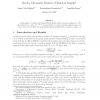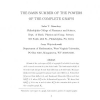3757 search results - page 46 / 752 » The overlap number of a graph |
STOC
2004
ACM
15 years 10 months ago
2004
ACM
Given d (0, ) let kd be the smallest integer k such that d < 2k log k. We prove that the chromatic number of a random graph G(n, d/n) is either kd or kd + 1 almost surely.
ICALP
2007
Springer
15 years 4 months ago
2007
Springer
In this paper we consider the classical Erd˝os-R´enyi model of random graphs Gn,p. We show that for p = p(n) ≤ n−3/4−δ , for any fixed δ > 0, the chromatic number χ...
APPROX
2004
Springer
15 years 3 months ago
2004
Springer
Given any integer d ≥ 3, let k be the smallest integer such that d < 2k log k. We prove that with high probability the chromatic number of a random d-regular graph is k, k + 1...
BMCBI
2010
14 years 10 months ago
2010
Background: Understanding of secondary metabolic pathway in plant is essential for finding druggable candidate enzymes. However, there are many enzymes whose functions are not yet...
DM
1998
14 years 9 months ago
1998
A basis of the cycle space C(G) of a graph G is h-fold if each edge of G occurs in at most h cycles of the basis. The basis number b(G) of G is the least integer h such that C(G) ...


